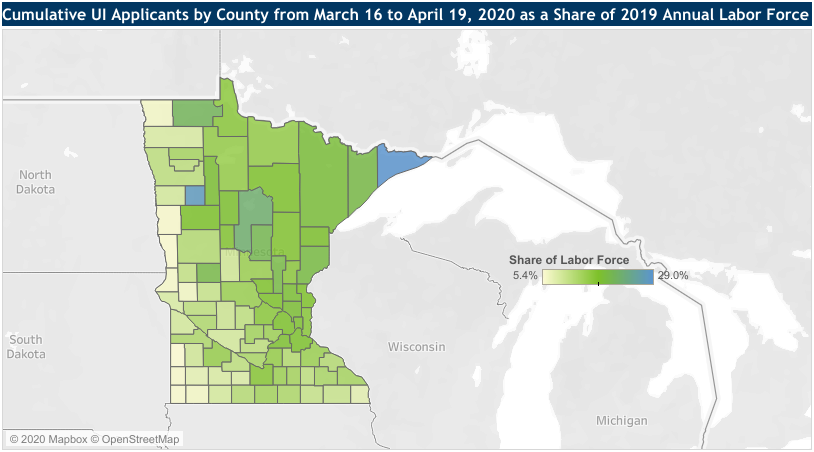How have the Coronavirus shutdown’s job losses varied across Minnesota?
New numbers from the Bureau of Labor Statistics show that, in March, there were 95,278 people unemployed in Minnesota and an unemployment rate of 3.1%. Since the Governor issued his shut down order on March 16th to combat the Coronavirus, 511,398 Minnesotans have filed for unemployment insurance (at the time of writing, 8:30am). If we assume that these folks have switched straight from the ‘employed’ to the ‘unemployed’ column, that implies a current unemployment rate of 19.8 percent.
For context, since the data began in January 1976, the previous peak was 8.9 percent between November 1982 and January 1983 – 10.9 percentage points below that current implied rate. The number of people working in Minnesota is now back at a level last seen in January 1997 when Jerry Maguire was in cinemas and Toni Braxton was top of the Billboard Hot 100 with Un-Break My Heart.
The same picture is seen across the country, but, so far, Minnesota is faring worse than many. As of April 11th, our state ranked 9th in the US for the share of its civilian workforce claiming unemployment compensation, as Figure 1 shows. When it comes to how many weeks of unemployment benefits our state’s trust fund can cover, as of April 4th, Minnesota ranks 36th with funding for 13 weeks, as Figure 2 shows.
Figure 1

Figure 2

I’ve written before about how the cost of fighting the Coronavirus has been disproportionately borne by some sectors of Minnesota’s labor force, specifically its female and black workers. Figure 3 shows how the burden in terms of lost jobs has varied across our state. In Lincoln County in the south west, new unemployment insurance applicants are 5.4% of the labor force. In Cook County, however, in the north east, the share is a staggering 29.0%.
Figure 3

Source: Department of Employment and Economic Development
There was some positive news last week when Gov. Walz gave 5,000 tests a day as a condition for reopening the state’s economy and the Mayo Clinic immediately said it could do that. That good news was badly needed.
John Phelan is an economist at the Center of the American Experiment.